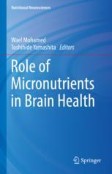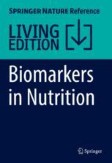Search
Search Results
-
Novel Nutraceutical Milk Compound in Alzheimer’s Prevention
Alzheimer’s disease gradually affects the nerves in the brain and leads to gradual memory loss. It is prevalent among the elderly and has negative...
-
Effects of Nutrients/Nutrition on Toxicants/Toxicity
There is no doubt that food components can interact with mammal’s biological functions. Nutrients or nutritional metabolism in the body can influence...
-
Vitamin-Based Derivatives for the Management of Alzheimer’s Disease
Vitamins are organic compounds; they help in the regulation of many bodily functions like cell proliferation and differentiation, immunological...
-
Connections Between Micronutrients, Cerebral Monoamines and Related Brain Disorders
Micronutrients provide the building units, precursors, vitamins, and the enzymatic cofactors required for correct biosynthesis of neurotransmitters,...
-
Role of ROS-Mediated Epigenetic Alterations in the Development of Solid Tumor
Tumorigenesis is one of the world’s major causes of death. Endogenous and exogenous factors are involved in the production of reactive oxygen species...
-
Targeting the Metabolism in Cancer Cells for Cancer Therapy
Cellular reactive oxygen species (ROS) are a group of extremely reactive molecules and are produced by metabolic and other reduction-oxidation...
-

-
Experimental Mammalian Cell Culture-Based Assays
Mammalian cell culture-based assays offer multiple vital clues to understanding several distinct physiological and pathophysiological events related...
-
Role of ROS-Mediated Epigenetic Alterations in the Development of Solid Tumor
Tumorigenesis is one of the world’s major causes of death. Endogenous and exogenous factors are involved in the production of reactive oxygen species...
-
Nanotechnology-Based Therapeutics in ROS-Induced Cancer
Cancer has long been linked to reactive oxygen species (ROS) and cellular oxidant stress. However, the mechanism of this link is complicated and...
-
Nanotechnology-Based Therapeutics in ROS-Induced Cancer
Cancer has long been linked to reactive oxygen species (ROS) and cellular oxidant stress. However, the mechanism of this link is complicated and...
-
Targeting the Metabolism in Cancer Cells for Cancer Therapy
Cellular reactive oxygen species (ROS) are a group of extremely reactive molecules and are produced by metabolic and other reduction-oxidation...
-
MAO-B Inhibitor (2E)-3-(4-Bromophenyl)-1-(1H-indol-3-yl) prop-2-en-1-one as a Neuroprotective Agent Against Alzheimer’s Disease
Chalcones ( trans -1,3-diphenyl-2-propen-1-ones) form simple chemical structures that act as precursors for the biogenesis of flavonoids. These are...

-
Enzymatic Biosensor Platforms for Diagnosis of Heart Diseases
Rapid diagnosis of cardiac ailments helps in the commencement of treatment at the earliest, preventing further loss of life of the patient. Over the...
-
Advanced Glycation End Products as Biomarkers in Nutrition
The human body is exposed to dietary advanced glycation end products (AGEs) – dAGEs ingested with food and the endogenous AGEs, which are...
-
Maternal nutrition and effects on offspring vascular function
Maternal nutrition during pregnancy may have profound effects on the develo** fetus and impact risk for cardiovascular disease later in life. Here,...

-
Endothelium-Derived Factors
The endothelium-dependent regulation of vascular tone is predominantly by four major players: nitric oxide (NO), prostaglandin I2 (PGI2),...
-
Advanced Glycation End Products as Biomarkers in Nutrition
The human body is exposed to dietary advanced glycation end products (AGEs) – dAGEs ingested with food and the endogenous AGEs, which are...
-
The Role of PKM2 in Multiple Signaling Pathways Related to Neurological Diseases
Pyruvate kinase M2 (PKM2) is a key rate-limiting enzyme in glycolysis. It is well known that PKM2 plays a vital role in the proliferation of tumor...

-
Inhibition of lysophosphatidic acid receptor 1–3 deteriorates experimental autoimmune encephalomyelitis by inducing oxidative stress
BackgroundLysophosphatidic acid receptors (LPARs) are G-protein-coupled receptors involved in many physiological functions in the central nervous...

